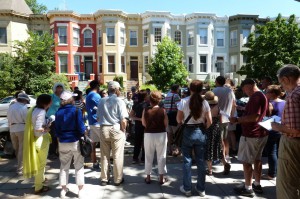Walking Tour of Swampoodle June 29, 2013
Posted on July 14th, 2013
Swampoodle Walking Tour Draws A Crowd Tour Handout
Well over 50 people recently enjoyed a beautiful Saturday morning to take a walking tour of Swampoodle – the corner of Capitol Hill immediately east of Union Station. The two hour tour drew interest from beyond the immediate area and greater Capitol Hill, with a few non DC residents as well. The numerous questions from the audience indicated a desire to understand how the neighborhood developed, and changed over time; where the name Swampoodle came from; the variety of Architectural styles, and local lore.
In the mid 1800s the low-lying land where the Tiber and Goose Creeks came together was not a particularly desirable place to live. Described by a news reporter as an area of “swamps and puddles” in his 1857 article on the dedication of St. Aloysius Church, it attracted immigrant families, particularly the Irish. Many resided in small alley dwellings that have been all but lost in Swampoodle, although similar alley dwellings remain scattered throughout Capitol Hill. After the creeks were culverted and covered over in 1876, conditions improved. By the late 1800’s larger houses were being built in multiple rows, distinguishing this area from the lot-by-lot development pattern found in Southeast and the older sections of Capitol Hill.
Today the neighborhood represents a microcosm of building styles ranging from very modest mid 19th Century structures; more elaborate Victorian residences of the late 1800s; as well as small apartment buildings and Craftsman style residences in beginning in the early 1900s. Most of the original Swampoodle neighborhood was demolished when construction of Union Station began in 1903. However you can still see evidence of the older neighborhood if you know where to look. For example, several houses along the north side of the 200 block of F Street and 600 block of Second Street, NE are nearly a full story below the street.
The oldest houses in the immediate area are modest flat front residences at 680 – 696 Fourth St., NE (1885); while a few doors down are a few relatively rare row house flats (1904). As the neighborhood improved, investments by prominent figures followed. A case in point is the row at 222 through 238 G Street, NE. These row houses were built by Senator John Sherman, and designed by T. F. Schneider in 1897. Schneider was famous – even infamous – for building the Cairo Hotel in 1894. A building judged so out of scale that it led directly to the Height of Buildings Act in 1899.
By the early 20th Century, architectural styles had changed, often reflecting the Beaux Arts/Neoclassical style popularized by the 1893 Columbian Exposition in Chicago. While Union Station may be the preeminent example in Washington, you can see residential examples in the row houses along the 300 Block (north side) of G Street, NE and the 700 Block (west side) of Fourth St., NE (1907 – 1908).
While there are a few mid to late 20th Century buildings in the area, the character and architectural styles of the late 1800s dominate. In recent years, large scale modern development has moved closer and even into the neighborhood. The large apartment building is currently under construction abutting the H Street overpass and covering roughly 60 percent of the square that contained several late 19th Century structures until 2008.



